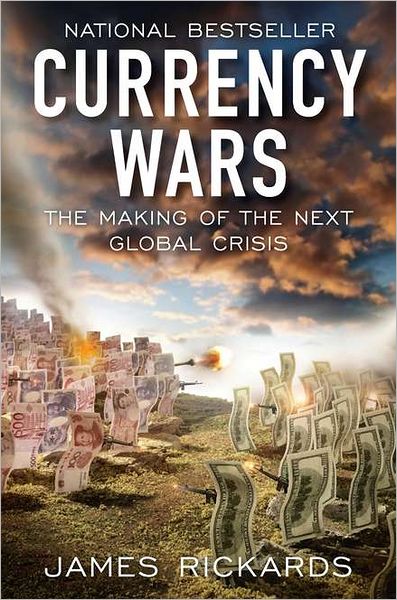I sometimes call it “the race to the bottom.”? During a time where most nations are feeling economically weak, some decide to weaken their currency, so that their exporters can do better, which supposedly preserves jobs in export industries.
Producers have concentrated interests, and lobby well.? The interests of consumers are diffuse, and don’t gain favor from governments kowtowing to producers, who also find more effective ways of rewarding political friends.
If we were intelligent, we would know this is a loser of a battle, and we would realize that this simply leads to inflation globally.? Better to sit it out, ignore the debasement, and realize it will eventually burn out.? Unlike the current Federal Reserve, don’t add to the debasement, it just adds fuel to the global inflationary fire.
This book starts with a currency war-gaming scenario.? In the game, the author pursues a course where on one of the non-US teams decides to link their currency to gold.? Initially derided, they end up as one of the victors at the end of the game, even though no one else follows them.
The book continues with an examination of three eras where currencies were at war: 1) prior to the Great Depression until we leave the internal gold standard, 2) the inflationary guns and butter late ’60s to mid ’80s, encompassing the period where the US goes off the gold standard entirely, and global currencies float.? We go through a period of high inflation after that, followed by an extreme rise in interest rates. 3) The book examines the present time, where every nation wants to devalue, so that it exporters are not harmed.
If we left the gold standard to get stability, we did not get it.? If we left the gold standard to benefit the global or US economies, the benefit has not appeared.
But, from chapters 7 through 10, the book muddles.? It talks about a wide variety of ideas loosely related to the main thesis, but proving little one way or another.? The book does not build toward its conclusion in chapter 11, where it suggests a return to a gold standard.
A gold standard exists to preserve purchasing power, and takes power out of the hands of governments that want to favor one set of parties over another, whether favoring savers or investors, producers or consumers.? It takes many questions out of the hands of the government, and reduces the need for an expensive central bank filled with PhDs in Economics who really have no idea how economies work, because they are mathematicians, and don’t get the broader societal ramifications of what their policies encourage.
I enjoyed this book, and would recommend it. The book isn’t linear to its goal, but you will learn a lot along the way, even if it is circuitous.
Quibbles
Already given.
Who would benefit from this book:?? This book is for those frustrated with the way that our government are handling monetary affairs, and are looking for a better way.? If you want to, you can buy it here: Currency Wars: The Making of the Next Global Crisis (Portfolio).
Full disclosure: The publisher asked me if I would like the book.? I said yes, and they sent me a copy.
If you enter Amazon through my site, and you buy anything, I get a small commission.? This is my main source of blog revenue.? I prefer this to a ?tip jar? because I want you to get something you want, rather than merely giving me a tip.? Book reviews take time, particularly with the reading, which most book reviewers don?t do in full, and I typically do. (When I don?t, I mention that I scanned the book.? Also, I never use the data that the PR flacks send out.)
Most people buying at Amazon do not enter via a referring website.? Thus Amazon builds an extra 1-3% into the prices to all buyers to compensate for the commissions given to the minority that come through referring sites.? Whether you buy at Amazon directly or enter via my site, your prices don?t change.

